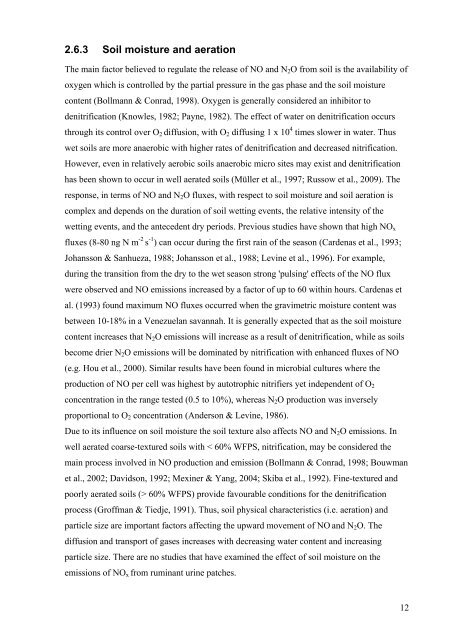Factors affecting nitric oxide and nitrous oxide emissions from ...
Factors affecting nitric oxide and nitrous oxide emissions from ...
Factors affecting nitric oxide and nitrous oxide emissions from ...
You also want an ePaper? Increase the reach of your titles
YUMPU automatically turns print PDFs into web optimized ePapers that Google loves.
2.6.3 Soil moisture <strong>and</strong> aeration<br />
The main factor believed to regulate the release of NO <strong>and</strong> N2O <strong>from</strong> soil is the availability of<br />
oxygen which is controlled by the partial pressure in the gas phase <strong>and</strong> the soil moisture<br />
content (Bollmann & Conrad, 1998). Oxygen is generally considered an inhibitor to<br />
denitrification (Knowles, 1982; Payne, 1982). The effect of water on denitrification occurs<br />
through its control over O2 diffusion, with O2 diffusing 1 x 10 4 times slower in water. Thus<br />
wet soils are more anaerobic with higher rates of denitrification <strong>and</strong> decreased nitrification.<br />
However, even in relatively aerobic soils anaerobic micro sites may exist <strong>and</strong> denitrification<br />
has been shown to occur in well aerated soils (Müller et al., 1997; Russow et al., 2009). The<br />
response, in terms of NO <strong>and</strong> N2O fluxes, with respect to soil moisture <strong>and</strong> soil aeration is<br />
complex <strong>and</strong> depends on the duration of soil wetting events, the relative intensity of the<br />
wetting events, <strong>and</strong> the antecedent dry periods. Previous studies have shown that high NOx<br />
fluxes (8-80 ng N m -2 s -1 ) can occur during the first rain of the season (Cardenas et al., 1993;<br />
Johansson & Sanhueza, 1988; Johansson et al., 1988; Levine et al., 1996). For example,<br />
during the transition <strong>from</strong> the dry to the wet season strong 'pulsing' effects of the NO flux<br />
were observed <strong>and</strong> NO <strong>emissions</strong> increased by a factor of up to 60 within hours. Cardenas et<br />
al. (1993) found maximum NO fluxes occurred when the gravimetric moisture content was<br />
between 10-18% in a Venezuelan savannah. It is generally expected that as the soil moisture<br />
content increases that N2O <strong>emissions</strong> will increase as a result of denitrification, while as soils<br />
become drier N2O <strong>emissions</strong> will be dominated by nitrification with enhanced fluxes of NO<br />
(e.g. Hou et al., 2000). Similar results have been found in microbial cultures where the<br />
production of NO per cell was highest by autotrophic nitrifiers yet independent of O2<br />
concentration in the range tested (0.5 to 10%), whereas N2O production was inversely<br />
proportional to O2 concentration (Anderson & Levine, 1986).<br />
Due to its influence on soil moisture the soil texture also affects NO <strong>and</strong> N2O <strong>emissions</strong>. In<br />
well aerated coarse-textured soils with < 60% WFPS, nitrification, may be considered the<br />
main process involved in NO production <strong>and</strong> emission (Bollmann & Conrad, 1998; Bouwman<br />
et al., 2002; Davidson, 1992; Mexiner & Yang, 2004; Skiba et al., 1992). Fine-textured <strong>and</strong><br />
poorly aerated soils (> 60% WFPS) provide favourable conditions for the denitrification<br />
process (Groffman & Tiedje, 1991). Thus, soil physical characteristics (i.e. aeration) <strong>and</strong><br />
particle size are important factors <strong>affecting</strong> the upward movement of NO <strong>and</strong> N2O. The<br />
diffusion <strong>and</strong> transport of gases increases with decreasing water content <strong>and</strong> increasing<br />
particle size. There are no studies that have examined the effect of soil moisture on the<br />
<strong>emissions</strong> of NOx <strong>from</strong> ruminant urine patches.<br />
12

















